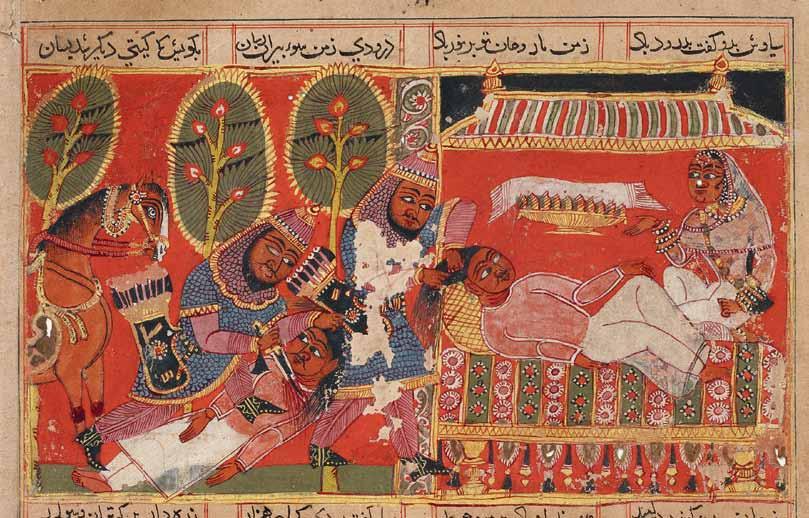
4 minute read
Master of the Jainesque Shahnama
Master of the Jainesque Shahnama Active 1425–40, in western India, probably Malwa
At every turn, this artist reveals his origins as one trained in the western Indian style so closely identified with Jain and Hindu manuscript painting. That he turned these skills to the illustration of the most famous of all Islamic epic narratives, the Shahnama (Book of Kings) of Firdawsi, was a daring and challenging move. The catalyst must have been a commission from a Muslim patron who, wishing to have an edition of this illustrated epic, sought out an accomplished local artist. The patron with such a keen interest was probably a local Sultanate ruler well versed in Persian literature, who already maintained a library containing imported Iranian illustrated manuscripts. Access to such works would have been essential to provide visual models for the Indian artist unfamiliar with either the imagery or the conventions of Iranian painting. The specific treatment of armored soldiers with their caparisoned horses draws directly on Iranian models, as does the depiction of rocky landscapes, sky-cloud boundaries, and specific icons such as the mythical bird Simurgh. For the more routine pictorial building blocks, the artist reverted to the tradition in which he was trained, as examples show in the stylization of trees and water and use of the Hindu-Jain convention of a red ground, which makes no provision for spatial needs. Most compelling of all are the figures, seen routinely in three-quarter profile, in a manner closely related to the Caurapancasika style. 19
Advertisement
This manuscript, in its original condition, was bound as a single codex format volume comprising 350 pages of Persian text, 66 of which are illustrated. 20 The artist confined all his paintings to a landscape format, never daring to fill the entire page, betraying his origins as one trained in the illustration of palm-leaf and paper manuscripts in the potli tradition. 21 Jain Kalpasutra and Hindu Balagopalastuti manuscripts provide contemporary models (No. 5 and Fig. 4).
This remarkable manuscript reflects a broader movement toward integration and cultural accommodation between occupier and occupied across Sultanate India, as foreign Muslim rulers imposed their authority over the Hindu majority. The culturally liberal approach for which the Mughal emperor Akbar (r. 1556–1605) is praised has its roots in the Sultanate era, as is vividly witnessed by these paintings. Unknowingly, this artist set in motion a series of dynamic exchanges between native Indian schools of painting and imported Iranian styles that would have profound consequences on the development of Indian painting in the century that followed.
3 Siyavash faces Afrasiyab across the Jihun River: page from a Shahnama manuscript Unknown workshop, possibly Malwa, ca. 1425–50 Inscribed: text of Firdawsi’s Shahnama Opaque watercolor and ink on paper, painting: 7 7 ⁄8 x 4 13 ⁄16 in. (20 x 12 cm); page: 12 11 ⁄16 x 9 1 ⁄4 in. (32 x 23.5 cm) Museum Rietberg, Zurich, Gift of Balthasar and Nanni Reinhart (RVI 964, f. 108v.) Published: Goswamy, A Jainesque Sultanate Shahnama (1988), fig. 10
The youthful prince Siyavash negotiates a peaceful accommodation of his clan’s rival king Afrasiyab. Both armies are represented in a style modeled after Iranian conventions of the period. The river divides the composition vertically and is treated in a basket-pattern design that can be traced back to Indian sculptures of the Shunga era. A narrow green band suggests a foreground space for the assembled armies, and the flat red middle ground fills the remaining space; no horizon or skyline is indicated. The aged king Afrasiyab is attended by guards bearing a parasol and fly whisk (chauri), insignia of office not seen in Iranian depictions of this subject, a confirmation of the Indian origins of this painter.

4 Siyavash is pulled from his bed and killed: page from a Shahnama manuscript Unknown workshop, possibly Malwa, 1425–50 Opaque watercolor and ink on paper, painting: 4 7 ⁄16 x 7 13 ⁄16 in. (11 x 19.8 cm);

page: 12 3 ⁄8 x 9 5 ⁄8 in. (31.5 x 24.5 cm) Museum Rietberg, Zurich, Gift of Lucy Rudolph and Ursula Dohrn (RVI 1881, f.120v) Published: Goswamy, A Jainesque Sultanate Shahnama (1988), fig. 18
In this dramatic murder scene, prince Siyavash is dragged by the hair from his bed chamber while his hapless wife Farangish gestures in horror. In a rare instance of continuous narrative, the murder and (presumed) decapitation are seen in the outdoor scene marked by trees. The juxtaposition of the Iraniandressed soldier and the Indian-styled pavilion and stylized trees bears witness to the hybridism of this manuscript’s painting style. Farangish wears a diaphanous shawl (orhani), rather than a tight-fitting choli bodice, a mode of dress unknown in Iranian painting. The intense red ground and other strident colors are the clearest indication that the artist’s origins are Indian.










